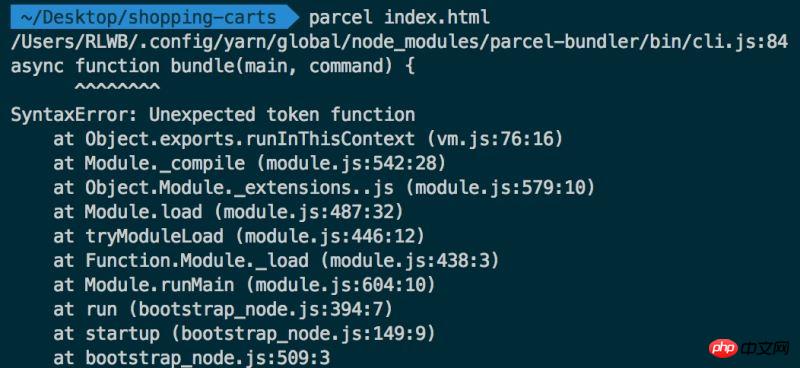Home >Web Front-end >JS Tutorial >Analysis of the entire process from parcel.js packaging error to nvm selection
This article mainly introduces the entire process from parcel.js packaging error to nvm selection. Friends in need can refer to it. I hope you can help everyone understand the entire process from parcel.js packaging error to nvm selection.
Encountered a problem
I encountered the following error when using parcel.js to package the project:

I am checking carefully After finishing the code and verifying that there were no problems with the project configuration, I had no choice but to turn to the almighty Google. As a result, I found the cause of the error on GitHub. parcel.js uses the Async function. By default, it is only supported by Node.js 8 or above, and below 8. If so, you need to use babel configuration. I checked my Node.js version, as follows:

After finding the cause of the problem, I thought upgrading node would solve the problem. But on second thought, the company's recent projects use node, and it would be troublesome to report errors if the project is upgraded rashly. At this time, I thought of nvm. In fact, I had seen it a long time ago. At that time, I felt that the node environment was already installed on my computer. It was troublesome to uninstall and reinstall it, so I didn’t use it. But now I need a new version of node to use parcel.js. I decided to uninstall node, install it again with nvm, and manage the node version.
The first problem I encountered was how to completely uninstall node on mac. Because it was installed using Homebrew, I felt that uninstalling it directly would not be complete. So I checked a lot of documents online, and my personal practice is as follows:
Completely uninstall node under Mac os
1. Delete all nodes and node_modules in /usr/local/lib
2. Delete all node and node_modules folders in /usr/local/lib
3. If installed from brew, run brew uninstall node
4. Check all local, lib or include folders in ~/ , delete all nodes and node_modules
5. In /usr/local/bin, delete all node executable files
6. Finally run the following code:
sudo rm /usr/local/bin/npm sudo rm /usr/local/share/man/man1/node.1 sudo rm /usr/local/lib/dtrace/node.d sudo rm -rf ~/.npm sudo rm -rf ~/.node-gyp sudo rm /opt/local/bin/node sudo rm /opt/local/include/node sudo rm -rf /opt/local/lib/node_modules
After completely uninstalling node , and then just install it step by step according to the nvm installation document on Github. With nvm, you can install it as you like and switch to any version of node you want.

Haha, it feels great to switch node versions at will.
Related recommendations:
How to deal with blank spaces after vue is packaged
Detailed explanation of Parcel packaging example
How to solve the packaged image path error in vue-cli
The above is the detailed content of Analysis of the entire process from parcel.js packaging error to nvm selection. For more information, please follow other related articles on the PHP Chinese website!